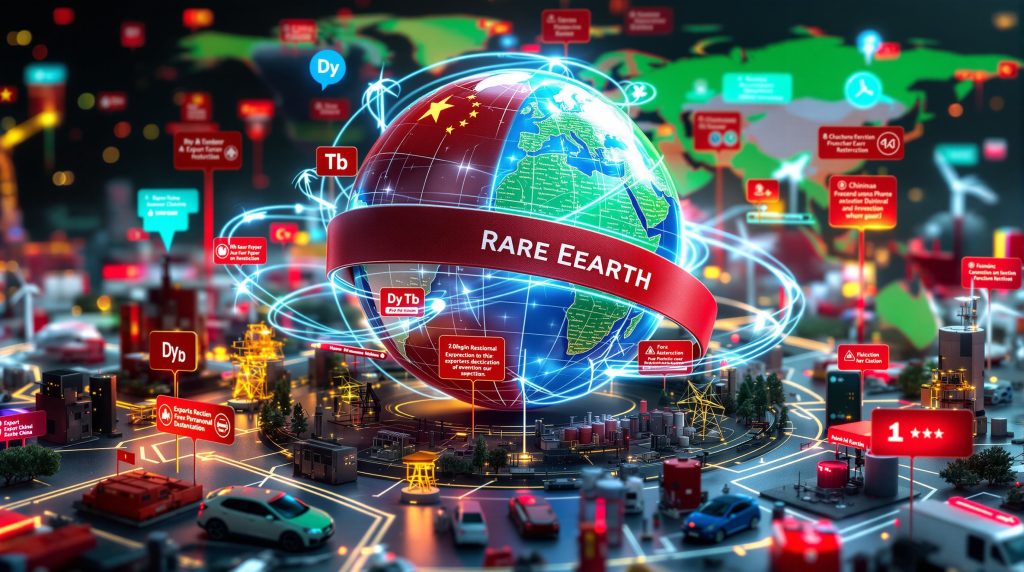China's Rare Earth Export Controls: Strategic Power Play in Global Tech Supply Chains
China's 2025 implementation of comprehensive rare earth export controls marks a pivotal shift in global critical mineral politics. These regulations extend far beyond conventional trade restrictions, establishing a complex regulatory framework with profound implications for technology supply chains, international relations, and strategic industries worldwide.
What Are China's 2025 Rare Earth Export Controls?
Comprehensive Licensing Framework
China's rare earth export control system implements stringent licensing requirements for a wide range of critical materials. According to Reuters, China began implementing controls targeting critical minerals including gallium, germanium, and graphite in late 2024, with expanded measures specifically targeting rare earth elements in 2025.
The regulatory framework extends beyond raw materials to encompass rare earth magnets, processing equipment, and even products containing trace amounts of Chinese-origin rare earths. This creates unprecedented supply chain documentation requirements for global manufacturers.
Companies must now navigate complex verification procedures, end-user certification processes, and material tracking systems to comply with the new regulations. The controls apply not only to direct exports from China but also to products manufactured using Chinese rare earth materials or technologies.
Materials and Technologies Under Restriction
The controls target strategically significant heavy rare earth elements including dysprosium, terbium, and gadolinium – critical components in high-performance permanent magnets used in defense systems and clean energy technologies. Light rare earths like neodymium and praseodymium, essential for electric vehicle motors and wind turbines, also face heightened restrictions.
U.S. Geological Survey data confirms China controls approximately 70% of global rare earth mining production and dominates 85-90% of processing capacity. This market concentration gives Beijing significant leverage in implementing these controls effectively.
The regulatory scope encompasses:
- Raw rare earth oxides and metals
- Processed compounds and alloys
- Finished permanent magnets
- Processing equipment and manufacturing technologies
- Technical data and manufacturing know-how
Why Is China Implementing These Export Controls Now?
Strategic Resource Leverage
China's dominant position in rare earth supply chains provides asymmetric leverage in international relations. The country produces approximately 240,000 metric tons of rare earth oxides annually, representing 70% of global production according to USGS data. Even more significantly, China operates 19 of the world's 20 rare earth separation facilities.
This control extends throughout the value chain, with Chinese companies producing approximately 92% of global rare earth magnets according to European Commission research. This market dominance creates vulnerabilities for industries ranging from defense to critical minerals energy security.
The timing of these controls appears strategically calculated, according to analysts at the Brookings Institution. They represent a direct response to Western technology restrictions, particularly U.S. semiconductor export controls implemented in October 2022 and expanded through 2023.
Response to Western Technology Restrictions
China's rare earth export controls emerge as a calculated counterbalance to Western technology restrictions. The Peterson Institute for International Economics notes that "Beijing views rare earth controls as asymmetric leverage in trade negotiations, where China holds significant advantages that are difficult for Western nations to quickly overcome."
This represents an evolution in China's approach to economic statecraft. Unlike previous rare earth restrictions in 2010-2011 that resulted in a WTO dispute China ultimately lost, the current controls are structured differently to avoid WTO violations by focusing on national security grounds rather than resource conservation.
The controls create strategic bargaining power in ongoing trade negotiations, protecting domestic industries while establishing leverage points in technology competition with Western nations.
How Does China's Foreign Direct Product Rule Transform Export Controls?
Extraterritorial Reach of Regulations
China's implementation of regulations similar to the U.S. Foreign Direct Product Rule represents an unprecedented extension of regulatory reach. According to the National Law Review, this approach "would represent unprecedented extraterritorial reach for Chinese export controls, mirroring the mechanism the United States has used to restrict technology access to Chinese companies like Huawei."
Under this framework, products manufactured entirely outside China could require Chinese export licenses if they:
- Incorporate Chinese-origin rare earth materials
- Are produced using Chinese technology or equipment
- Contain components manufactured with Chinese inputs
This creates complex compliance challenges for global supply chains, where rare earth materials may pass through multiple countries and manufacturing processes before reaching end products.
Compliance Mechanisms and Enforcement
The compliance burden falls heavily on global manufacturers, who must now implement sophisticated tracking systems to document material origins throughout their supply chains. The law firm White & Case notes that these requirements create "complex compliance obligations for global supply chains" by requiring license applications for products manufactured outside China.
Implementation challenges include:
- Tracing rare earth content through multi-tier supply chains
- Distinguishing between materials from different source countries
- Verifying end-user and end-use information
- Managing licensing procedures and documentation requirements
These provisions create particular challenges for industries with complex, globalized supply chains like automotive, electronics, and defense systems.
What Industries Face the Greatest Vulnerability?
Defense and Aerospace Applications
The defense sector faces acute vulnerabilities from rare earth export controls. According to the U.S. Government Accountability Office, approximately 90% of precision-guided weapons systems rely on rare earth permanent magnets. Each F-35 fighter aircraft requires approximately 920 pounds of rare earth materials.
Critical defense systems with rare earth dependencies include:
- Precision-guided munitions and their guidance systems
- Radar and communications equipment
- Military aircraft and naval propulsion systems
- Night vision devices and targeting systems
The Center for a New American Security notes that "rare earth dependencies in defense systems represent a critical vulnerability, as substitutes often reduce performance or require extensive redesign and testing, processes that can take 5-10 years for complex weapons systems."
Electric Vehicle and Renewable Energy Sectors
The clean energy transition faces significant risk from China rare earth export controls. According to the International Energy Agency, approximately 90% of electric vehicles sold globally in 2023 used rare earth permanent magnet motors, with each vehicle requiring 1-3 kilograms of rare earth elements.
Wind energy faces similar challenges, with permanent magnet generators accounting for approximately 40% of new turbine installations globally. Each megawatt of offshore wind capacity requires approximately 200 kilograms of rare earth permanent magnets.
The Rocky Mountain Institute observes that "export controls on rare earth elements create a direct conflict between national security objectives and climate goals, as restrictions could slow the deployment of electric vehicles and renewable energy systems critical for emissions reductions."
Consumer Electronics and Advanced Manufacturing
Consumer electronics manufacturers face substantial exposure to rare earth supply chain disruptions. Smartphones, hard drives, speakers, and countless other devices incorporate rare earth magnets, phosphors, and other compounds.
Key applications include:
- Smartphone speakers and vibration motors
- Hard disk drive motors and actuators
- Camera autofocus mechanisms
- Headphones and audio equipment
While individual devices contain relatively small amounts of rare earth elements, the massive scale of global electronics production creates significant aggregate demand, making this sector particularly sensitive to supply disruptions and price volatility.
How Are Global Markets Responding to These Controls?
Price Dynamics and Supply Chain Reactions
Rare earth markets have responded to China's rare earth export controls with significant price volatility. According to market data from Asian Metal and Fastmarkets, dysprosium oxide prices increased 49% in 2024, while terbium oxide prices rose 54% during the same period.
This price volatility reflects both actual supply constraints and market psychology around future availability. Benchmark Mineral Intelligence reports that "buyers increasingly pay premiums for non-Chinese material, even when Chinese supply remains technically available. This 'security premium' reflects long-term supply chain risk rather than immediate shortages."
Market participants are adopting various strategies to manage supply risks, including:
- Strategic inventory buildup and stockpiling
- Long-term supply agreements with non-Chinese producers
- Investment in recycling and recovery capabilities
- Development of material substitutes where technically feasible
Investment Patterns in Alternative Sources
Capital investment in non-Chinese rare earth supply chains has accelerated dramatically in response to export controls. S&P Global Market Intelligence reports that global investment in rare earth projects outside China reached $3.2 billion in 2024, up from $1.8 billion in 2023.
Notable projects include:
- Lynas Rare Earths' $650 million expansion of its Kalgoorlie processing facility in Australia
- MP Materials' $700 million investment in a Texas rare earth separation facility
- Energy Fuels' commercial rare earth production at White Mesa Mill in Utah
Wood Mackenzie notes that "capital flows into rare earth projects have accelerated dramatically, but most projects face 5-7 year development timelines. The disconnect between immediate supply concerns and long-term project delivery creates sustained market volatility."
What Strategies Are Countries Adopting to Reduce Rare Earth Vulnerabilities?
Diversification of Global Supply Sources
Countries are pursuing aggressive strategies to diversify rare earth supply chains. Australia has emerged as a leading alternative supplier, producing approximately 22,000 metric tons of rare earth oxides in 2023 and targeting 35,000 metric tons by 2027 according to the Australian Department of Industry.
The United States has revitalized domestic production at Mountain Pass, California, reaching approximately 43,000 metric tons in 2023. Canada has multiple projects in development with potential combined capacity of 15,000 metric tons annually.
However, processing capacity remains a critical bottleneck. While mining industry evolution is expanding globally, separation and refining capabilities remain concentrated in China. Developing this midstream capacity requires substantial investment and technical expertise.
Policy and Regulatory Responses
Governments worldwide have implemented strategic responses to rare earth vulnerabilities. Key initiatives include:
- The U.S. has allocated $2.3 billion through Defense Production Act authorities for critical mineral supply chains
- The European Union established a €1.5 billion fund through its Critical Raw Materials Act
- Australia created a AUD $1.5 billion Australia critical minerals reserve to support project development
The U.S. Defense Logistics Agency has significantly increased rare earth stockpiling targets, with dysprosium inventory targets increased by 30% and terbium by 25% in 2024.
The Atlantic Council observes that while Western critical minerals strategies share common elements, "implementation timelines remain overly optimistic given technical and permitting challenges."
How Might These Controls Impact US-China Relations?
Trade Negotiation Dynamics
China's rare earth export controls introduce new complexity to an already challenging US-China trade relationship. These controls provide Beijing with leverage points in ongoing negotiations, particularly regarding technology restrictions and semiconductor export controls.
The regulations create potential for escalating countermeasures. U.S. policymakers face difficult choices about how to respond to these controls without triggering further supply chain restrictions that could harm American manufacturers.
Critical negotiation points include:
- The scope and implementation of licensing requirements
- Verification mechanisms and compliance procedures
- Exemptions for specific industries or applications
- Reciprocal market access provisions
The relationship between rare earth controls and broader US‑China trade war impact remains a central factor in bilateral relations.
National Security Considerations
Rare earth dependencies create significant national security concerns for the United States and its allies. Defense systems with rare earth requirements include:
- Virginia-class submarines, which use approximately 9,200 pounds of rare earth permanent magnets
- F-35 fighter aircraft, with approximately 920 pounds of rare earth materials per plane
- Precision-guided munitions and their guidance systems
- Advanced radar and electronic warfare systems
These dependencies have elevated critical minerals to a core national security priority, with implications for defense industrial base policy, technology development, and international security arrangements.
What Implementation Challenges Do These Controls Face?
Technical Verification Difficulties
Implementing rare earth export controls presents significant technical challenges. Tracing rare earth content through complex global supply chains requires sophisticated testing and documentation systems that do not currently exist at scale.
Practical difficulties include:
- Distinguishing between rare earth materials from different source countries once processed
- Verifying material origins in finished components and systems
- Establishing chain-of-custody documentation across multi-tier supply chains
- Developing testing protocols for trace amounts of controlled materials
These technical challenges create opportunities for circumvention through third countries, material substitution, or documentation irregularities.
Administrative and Enforcement Hurdles
China's regulatory authorities face substantial administrative challenges in implementing these controls effectively. Processing thousands of license applications requires significant administrative capacity, technical expertise, and enforcement resources.
Balancing control objectives with economic interests creates additional tensions. Chinese rare earth producers and magnet manufacturers rely on export markets, creating domestic pressure to avoid overly restrictive implementation that could harm Chinese companies.
Preventing circumvention through third countries presents particular challenges, as materials may be incorporated into components or systems that disguise their origin or classification.
What Long-Term Impacts Could These Controls Have on Global Supply Chains?
Structural Changes to Industrial Organization
China's export controls are accelerating fundamental changes in how critical mineral supply chains are structured. These include:
- Increased vertical integration, with manufacturers taking ownership positions in mining and processing operations
- Reshoring of critical manufacturing to reduce supply chain vulnerabilities
- "Friend-shoring" to concentrate supply chains within geopolitically aligned countries
- Development of parallel supply systems for critical components
These structural changes represent a significant departure from the globalized, efficiency-focused supply chains that dominated the early 21st century, emphasizing resilience and security over cost optimization.
Technological Adaptation and Innovation
Export controls are driving significant innovation in material science and supply chain management. Key technological responses include:
- Development of reduced-dysprosium or dysprosium-free magnet formulations
- Research into alternative motor designs that eliminate rare earth requirements
- Advanced recycling technologies to recover rare earth elements from end-of-life products
- Digital tracking systems to verify material provenance throughout supply chains
While these innovations may eventually reduce rare earth dependencies, most require several years of development and commercialization before achieving significant market impact.
How Effective Are China's Export Controls Likely to Be?
Strategic Objectives and Practical Limitations
China's export controls must balance competing objectives. While they provide strategic leverage in international relations, excessively strict implementation could accelerate supply diversification efforts and harm Chinese producers dependent on export markets.
Practical limitations include:
- Enforcement capacity constraints across complex global supply chains
- Potential for circumvention through third countries or material substitution
- Administrative burdens of processing thousands of license applications
- Market adaptations that reduce demand for controlled materials
The Center for Strategic and International Studies describes China's approach as "a fundamental shift in how Beijing leverages its dominance in critical mineral supply chains as a tool of economic statecraft."
International Response Effectiveness
The effectiveness of international responses depends on coordination among affected countries, investment timelines, and technological adaptation. Critical factors include:
- Speed of developing alternative supply sources relative to Chinese capacity growth
- Success in establishing processing capacity outside China
- Effectiveness of material substitution and design adaptation
- International coordination on critical mineral policies
These factors will determine whether China's rare earth export controls represent a temporary disruption or a permanent restructuring of global technology supply chains.
FAQ: Understanding China's Rare Earth Export Controls
What specific rare earth elements are most affected?
Heavy rare earths face the most stringent controls, particularly dysprosium, terbium, and gadolinium. These elements are critical for high-performance magnets used in defense applications and clean energy technologies, with limited supply sources outside China.
Price data confirms this impact, with dysprosium oxide prices increasing 49% and terbium oxide prices rising 54% in 2024. These elements face particular supply constraints due to their geological scarcity and concentration in specific Chinese deposits.
How do manufacturers verify compliance with these regulations?
Compliance requires comprehensive supply chain documentation, including:
- Material origin certificates for rare earth inputs
- Processing history documentation
- End-use and end-user verification
- License applications for products containing controlled materials
These requirements create substantial administrative burdens, particularly for complex products with multiple tiers of suppliers and numerous components containing rare earth elements.
Can companies avoid these controls by sourcing from other countries?
While alternative mining sources exist in Australia, the United States, and Canada, China's dominance in processing creates persistent dependencies. Approximately 85-90% of global rare earth separation capacity remains in China, meaning most materials pass through Chinese facilities regardless of mine origin.
Developing fully independent supply chains requires not only mining investment but also substantial development of separation, refining, and magnet manufacturing capacity – processes that typically require 5-7 years to establish at commercial scale.
What steps should businesses take to mitigate supply disruptions?
Companies facing rare earth supply vulnerabilities should implement multi-faceted strategies:
- Conduct comprehensive supply chain mapping to identify exposure points
- Develop relationships with non-Chinese suppliers where available
- Evaluate product designs for rare earth reduction opportunities
- Establish strategic inventory positions for critical materials
- Invest in recycling and material recovery capabilities
These approaches can reduce vulnerability while longer-term solutions like alternative materials and redesigned products are developed.
Conclusion: The Geopolitical Chess Game of Critical Minerals
Balancing Power and Economic Interests
China's implementation of rare earth export controls represents a strategic calculation that critical minerals provide unique leverage in international relations. These controls demonstrate Beijing's willingness to use its dominant supply position as a tool of economic statecraft, particularly in response to Western technology restrictions.
This approach requires careful calibration to avoid undermining China's own economic interests. Excessively strict implementation could accelerate supply diversification efforts and harm Chinese producers dependent on export markets.
The resulting dynamic creates a complex geopolitical chess game where rare earth elements represent strategic pieces in a broader competition for technological advantage and economic influence.
Transforming Global Supply Chain Structures
The long-term impact of these controls extends beyond immediate market disruptions to fundamental questions about how critical technology supply chains should be structured. The efficiency-focused globalization that characterized early 21st century supply chains is giving way to security-oriented approaches that emphasize resilience over cost optimization.
This transformation includes:
- Accelerated development of alternative supply sources
- Increased vertical integration across supply chains
- Greater emphasis on recycling and circular economy approaches
- Technological innovation to reduce critical material dependencies
While these changes represent significant challenges for affected industries, they may ultimately create more resilient and sustainable supply systems for the technologies that drive the modern economy. Furthermore, recent US critical minerals order initiatives indicate an intensifying global competition for securing stable supply chains independent of geopolitical rivals.
Looking to Spot the Next Major Mineral Discovery?
Discovery Alert's proprietary Discovery IQ model instantly notifies investors of significant ASX mineral discoveries, transforming complex data into actionable investment insights for both short-term traders and long-term investors. Explore how historic discoveries have generated substantial returns by visiting Discovery Alert's dedicated discoveries page and begin your 30-day free trial today.




